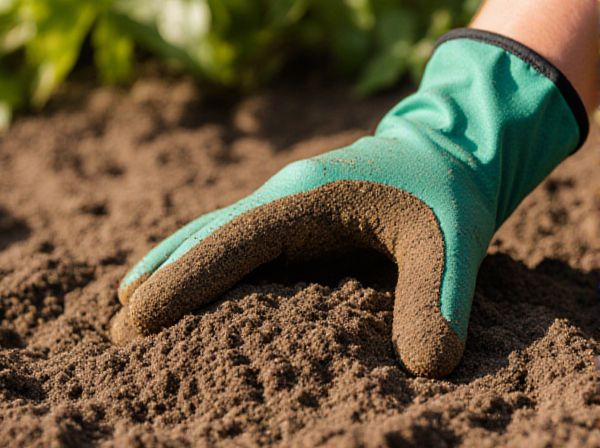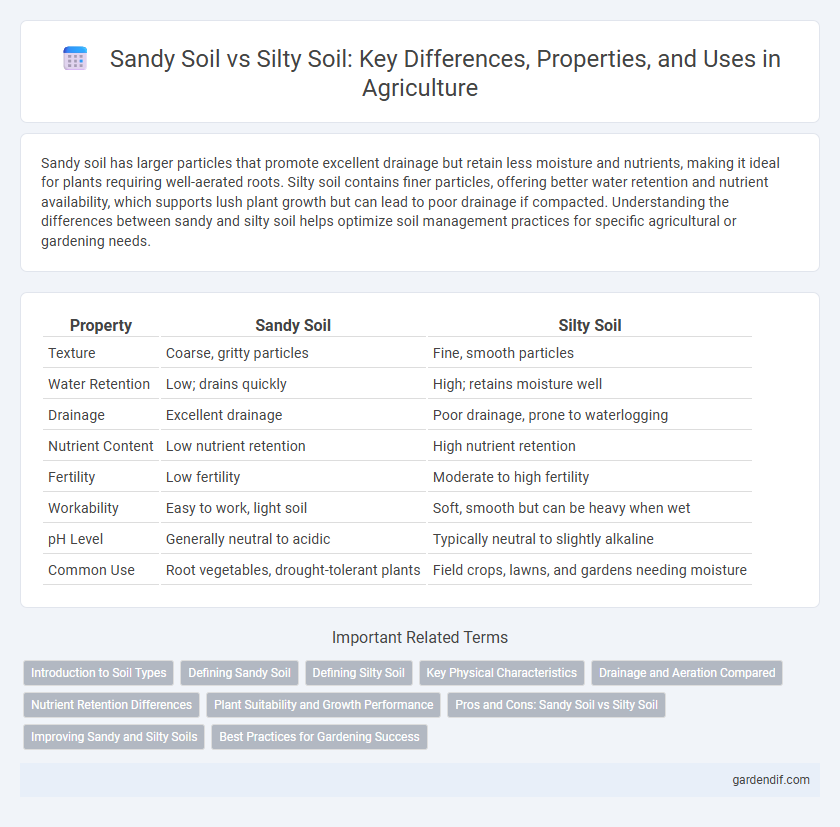
Sandy soil vs Silty soil Illustration
Sandy soil has larger particles that promote excellent drainage but retain less moisture and nutrients, making it ideal for plants requiring well-aerated roots. Silty soil contains finer particles, offering better water retention and nutrient availability, which supports lush plant growth but can lead to poor drainage if compacted. Understanding the differences between sandy and silty soil helps optimize soil management practices for specific agricultural or gardening needs.
Table of Comparison
| Property | Sandy Soil | Silty Soil |
|---|---|---|
| Texture | Coarse, gritty particles | Fine, smooth particles |
| Water Retention | Low; drains quickly | High; retains moisture well |
| Drainage | Excellent drainage | Poor drainage, prone to waterlogging |
| Nutrient Content | Low nutrient retention | High nutrient retention |
| Fertility | Low fertility | Moderate to high fertility |
| Workability | Easy to work, light soil | Soft, smooth but can be heavy when wet |
| pH Level | Generally neutral to acidic | Typically neutral to slightly alkaline |
| Common Use | Root vegetables, drought-tolerant plants | Field crops, lawns, and gardens needing moisture |
Introduction to Soil Types
Sandy soil consists of large, coarse particles that promote excellent drainage but have low nutrient retention, making it ideal for plants requiring well-aerated roots. Silty soil features fine, smooth particles that retain moisture and nutrients more effectively, supporting a wide variety of plant life. Understanding these soil types is essential for optimizing agricultural productivity and garden management.
Defining Sandy Soil
Sandy soil is characterized by large, coarse particles that create a gritty texture and allow for excellent drainage and aeration. Compared to silty soil, sandy soil has lower nutrient retention and water-holding capacity, making it less fertile but easier to work with in gardening and construction. Its high permeability results in rapid drying, which impacts plant growth and irrigation needs.
Defining Silty Soil
Silty soil is characterized by its fine particles, which are smaller than sand but larger than clay, providing a smooth texture and high fertility. It retains moisture well due to its moderate permeability, making it ideal for crop cultivation and plant growth. Unlike sandy soil, silty soil holds nutrients better, promoting healthier root development and improved soil structure.
Key Physical Characteristics
Sandy soil is characterized by large, coarse particles that allow for excellent drainage and aeration but have low nutrient retention. Silty soil consists of finer particles that retain moisture and nutrients better than sandy soil, promoting fertile conditions for plant growth. Both soils vary significantly in texture, affecting water retention, nutrient availability, and suitability for different crops.
Drainage and Aeration Compared
Sandy soil exhibits superior drainage and aeration due to its large particle size and loose texture, allowing water to pass through quickly and air to circulate easily. Silty soil retains more moisture because of its finer particles, resulting in slower drainage but moderate aeration. Gardeners often prefer sandy soil for plants requiring well-drained conditions, while silty soil supports moisture-loving species yet may risk waterlogging.
Nutrient Retention Differences
Sandy soil has larger particles and drains water quickly, resulting in lower nutrient retention compared to silty soil, which has finer particles that hold nutrients more effectively. Silty soil's better nutrient-holding capacity enhances plant growth by providing a more consistent supply of essential minerals. This difference in nutrient retention influences crop yield and soil management practices in agriculture.
Plant Suitability and Growth Performance
Sandy soil offers excellent drainage but has low nutrient retention, making it suitable for drought-tolerant plants like succulents and root vegetables. Silty soil retains moisture and nutrients better, supporting a wider variety of crops such as leafy greens and legumes with improved growth performance. Plants in silty soil generally exhibit faster development and higher yields due to enhanced nutrient availability and moisture retention.
Pros and Cons: Sandy Soil vs Silty Soil
Sandy soil offers excellent drainage and aeration, which benefits root growth but suffers from poor nutrient retention and low water-holding capacity, making it prone to drought stress. Silty soil retains moisture and nutrients more effectively, promoting healthy plant development, yet it risks compaction and poor drainage, which can lead to root rot and poor aeration. Choosing between sandy and silty soil depends on specific crop needs and local climate conditions, balancing drainage against moisture and nutrient availability.
Improving Sandy and Silty Soils
Improving sandy soil involves adding organic matter such as compost or manure to enhance water retention and nutrient availability, while incorporating clay or silt can help increase its fertility and moisture-holding capacity. Silty soil benefits from proper drainage management and the addition of coarse sand or organic materials to prevent compaction and improve aeration. Both soil types require regular monitoring of pH levels and nutrient content to optimize plant growth and maintain soil health.
Best Practices for Gardening Success
Sandy soil offers excellent drainage and warms quickly in spring, making it ideal for plants requiring well-drained conditions, while silty soil retains moisture and nutrients better, supporting a wider range of garden plants. To optimize gardening success in sandy soil, incorporate organic matter such as compost to improve moisture retention and nutrient content. When working with silty soil, ensure proper drainage and avoid compaction by adding coarse sand or organic mulch to maintain aeration and root health.
Sandy soil vs Silty soil Infographic

 gardendif.com
gardendif.com